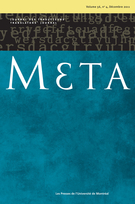Abstracts
Abstract
The paper investigates the notion of Translation Units (TUs) from a cognitive angle. A TU is defined as the translator’s focus of attention at a time. Since attention can be directed towards source text (ST) understanding and/or target text (TT) production, we analyze the activity data of the translators’ eye movements and keystrokes. We describe methods to detect patterns of keystrokes (production units) and patterns of gaze fixations on the source text (fixation units) and compare translation performance of student and professional translators. Based on 24 translations from English into Danish of a 160 word text we find major differences between students and professionals: Experienced professional translators are better able to divide their attention in parallel on ST reading (comprehension) and TT production, while students operate more in an alternating mode where they either read the ST or write the TT. In contrast to what is frequently expected, our data reveals that TUs are rather coarse units as compared to the notion of ‘translation atom,’ which coincide only partially with linguistic units.
Keywords:
- human translation process,
- granularity of translation units,
- production unit,
- fixation unit,
- attention in translation
Résumé
Le présent article examine la notion d’unités de traduction (UT) sous un angle cognitif. Une UT est définie comme l’unité sur laquelle l’attention du traducteur se focalise. L’attention pouvant être dirigée vers la compréhension du texte source (ST) ou la production du texte cible (TT), ou les deux, le mouvement des yeux et le rythme de frappe des traducteurs sont tous deux analysés. Nous décrivons des méthodes permettant de repérer les motifs de frappe (unités de production) et les schémas de fixation du regard sur le texte source (unités de fixation). De plus, nous comparons les performances des étudiants avec celles des traducteurs professionnels. La principale différence entre les étudiants et les traducteurs professionnels réside dans le fait que ceux-ci sont mieux en mesure de diviser leur attention et de l’accorder de façon parallèle à la lecture ST (compréhension) et à la production de TT, tandis que les étudiants tendent à alterner la lecture du ST et la rédaction du TT. Enfin, contrairement à ce qui est généralement attendu, nos données révèlent que les UT sont assez grossières, comparativement à la notion d’« atome de traduction », qui coïncide seulement partiellement avec les unités linguistiques.
Mots-clés :
- processus de traduction humaine,
- granularité des unités de traduction,
- unité de production,
- unité de fixation,
- attention en traduction
Appendices
Bibliography
- Alves, Fabio and Vale, Daniel Couto (2009): Probing the Unit of Translation in time: aspects of the design and development of a web application for storing, annotating and querying translation process data. Across Language and Cultures. 10(2):251-273.
- Anderson, John R. (2000): Cognitive Psychology and its Implications. New York: Worth.
- Bennett, Paul (1994): The Translation Unit in Human and Machine. Babel. 40(1):12-20.
- Carl, Michael (2009): Triangulating product and process data: quantifying alignment units with keystroke data. Copenhagen Studies in Language. 38:225-247.
- Carl, Michael and Buch-Kromann, Matthias (2010): Correlating Translation Product and Translation Process Data of Professional and Student Translators. In: François Yvon et Viggo Hansen, eds. Proceedings of the 14th Annual Conference of the European Association for Machine Translation (EAMT 2010, Saint-Raphaël, 27-28 May 2010). Visited on 24 August 2011, http://www.mt-archive.info/EAMT-2010-TOC.htm.
- Carl, Michael and Jakobsen, Arnt Lykke (2010): Towards statistical modelling of translators’ activity data. International Journal of Speech Technology. 12(4):125-138.
- Dagan, Ido, Church, Kenneth. W. and Gale, William A. (1993): Robust bilingual word alignment for machine aided translation. In: Proceedings of theWorkshop On Very Large Corpora: Academic And Industrial Perspectives (Columbus, 22 June 1993), 1-8. Visited on 24 August 2011, http://aclweb.org/anthology-new/W/W93/W93-0300.pdf.
- Dragsted, Barbara (2010): Coordination of reading and writing processes in translation: An eye on uncharted territory. In: Gregory M. Shreve and Erik Angelone, eds. Translation and Cognition. Amsterdam: John Benjamins, 41-62.
- Dragsted, Barbara and Hansen, Inge G. (2008): Comprehension and production in translation: a pilot study on segmentation and the coordination of reading and writing processes. Copenhagen Studies in Language. 36:9-12.
- Göpferich, Susanne (2007): Translationsprozessforschung. Tübingen: Gunter Narr.
- Jakobsen, Arnt Lykke (1999): Logging target text production with Translog. Copenhagen Studies in Language. 24:9-20.
- Jensen, Cristian (2008): Assessing eye-tracking accuracy in translation studies. Copenhagen Studies in Language. 36:157-174.
- Jensen, Kristian T. H. (2009): Distribution of attention between source text and target text during translation. In: Sharon O’Brien, ed. Continuum studies in translation – Cognitive exploration of translation. London: Continuum International Publishing Group, 215-237.
- Just, Marcel Adam and Carpenter, Patricia A. (1980): A theory of reading: from eye fixations to comprehension. Psychological Review. 87(4):329-354.
- Kondo, Fumiko (2007): Translation Units in Japanese-English Corpora: The Case of Frequent Nouns. In: Proceedings from Corpus Linguistics Conference Series (Birmingham, 27-30 July 2007). Article 203, 15 pp. Visited on 24 August 2011, http://www.birmingham.ac.uk/research/activity/corpus/publications/conference-archives/2007-birmingham.aspx.
- Kromann, Matthias (2003): The Danish dependency treebank and the DTAG treebank tool. In: Joakim Nivre and Erhard Hinrichs, eds. Proceedings of the Second Workshop on Treebanks and Linguistic Theories. Växjö: Växjö University Press, 217-220.
- Malmkjaer, Kirsten (2006): Translation Units. In: Keith Brown, Anne H. Anderson, Laurie Bauer, et al., eds. Encyclopaedia of Language and Linguistics. London: Elsevier, 92.
- Perrin, Daniel (2003): Progression Analysis (PA): Investigating Writing Strategies at the Workplace. Pragmatics. 35:907-921.
- Radach, Ralph, Kennedy, Alan and Rayner, Keith (2004): Eye Movements and Information Processing During Reading. Hove: Psychology Press.
- Ruiz, Carmen, Paredes, Natalia, Macizo, Pedro, et al. (2008): Activation of lexical and syntactic target language properties in translation. Acta Psychologica. 128(3):490-500.
- Sager, Juan C. (1993): Language Engineering and Translation. Consequences of Automation. Amsterdam: John Benjamins.
- Sharmin, Selina, Špakov, Oleg, Räihä, Kari, et al. (2008): Where on the screen do translation students look? Copenhagen Studies in Language. 36:30-51.
- Špakov, Oleg (2008): GazetoWord Mapping (GWM) tool, COM interface description, Version 1.2.3.60. Technical report, University of Tampere.
- Vinay, Jean-Paul and Darbelnet, Jean (1958): Stylistique comparée du français et de l’anglais. Paris: Didier.

